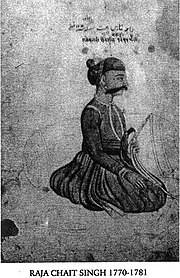
Back बनारस राज Bihari বেনারস রাজ্য Bengali/Bangla Estat de Benarés Catalan Benares (Staat) German État de Bénarès French बनारस रियासत Hindi Benares (stato) Italian 베나레스국 Korean Benares (fyrstestat) NB ਕਾਸ਼ੀ ਰਾਜ Punjabi
This article may need to be rewritten to comply with Wikipedia's quality standards. (March 2024) |
State of Benares | |||||||
|---|---|---|---|---|---|---|---|
| 1911–1948 | |||||||
 | |||||||
 Benares State in the Imperial Gazetteer of India | |||||||
| Capital | Benares | ||||||
| Common languages | Bhojpuri, Hindi-Urdu, English | ||||||
| Religion | Hinduism (official), Islam, Jainism, Buddhism, Christianity | ||||||
| Raja | |||||||
• 1740 – 1770 (first) | Balwant Singh | ||||||
• 1939 – 1947 (last) | Vibhuti Narayan Singh | ||||||
| History | |||||||
• Established | 1737 | ||||||
| 1948 | |||||||
| |||||||
| Today part of | Varanasi and Chakia in Uttar Pradesh, India | ||||||



Banaras State, earlier Benares Estate,[1] was an estate, or hereditary jagir, comprising the family domains of the Maharaja of Benares—under the Nawabs of Oudh, East India Company rule, and the British Raj—that from 1911 to 1948 was recognized as a princely state.[2]
The state was founded by the Gautam Bhumihar Brahmin zamindar, Balwant Singh, who assumed the title of "Raja of Benares" in mid 18th century, taking advantage of the Mughal Empire's disintegration.[3][4] His descendants ruled the area around Benares after liberation from Awadh and later as feudatories of East India Company. In 1910, Benares became a full-fledged state of India.[5] The state was merged in India after India's independence in 1947, but even today the Kashi Naresh (the titular ruler) is highly respected by the people of Varanasi.[6] The Ruler of Benaras was the state's religious head and the people of Benares considered him to have been ordained the throne of Kashi by Lord Shiva (making him Kashi Naresh by proxy). He was also the chief cultural patron and an essential part of all religious celebrations. In 1948, the 88th ruler of Kashi Sir Vibhuti Narayan Singh accepted the request of the first Indian Prime minister Jawaharlal Nehru and signed the accession to the Indian Union.[7]
- ^ Under the Authority of His Majesty's Secretary of State for India in Council (1908), "Benares Estate", Imperial Gazetteer of India, volume VII Bareilly to Berasia, Oxford, at the Clarendon Press, pp. 187–188,
Benares Estate.— An estate, usually known as the Family Domains of the Maharaja of Benares, comprising the tahsils of GANGAPUR in Benares District and Koru or Bhadohi and Chakia in Mirzapur District, United Provinces. 'The total area is 988 square miles, and the revenue due to Government from Gangapur and Korh is 3 lakhs, Chakia being held revenue-free, while the rent-roll is about 10 lakhs. The Maharaja is exempted from the payment of cesses on account of the Domains, and under Act I of 1904 has recently been authorized to collect certain rates which will be applied in the same manner as local rates in ordinary Districts. Besides his Family Domains the Maharaja owns a large area of samindari land in the Districts of Benares, Ghazipur, Ballia, Jaunpur, Allahabad, Mirzapur, and Shahabad (Bengal), with a rent-roll of 7 lakhs, paying 3-9 lakhs revenue and Rs. 59,000 cesses. The founder of the family was Mansa Ram, a Bhumihar, who entered the service of Rustam Ali, governor of Benares, under the Nawab of Oudh.
- ^ Cohen, Saul B., ed. (2008), The Columbia Gazetteer of the World, Volume I, A–G (2 ed.), Columbia University Press, p. 382, ISBN 978-0-231-14554-1,
Benares, former princely state, N INDIA, created in 1911; Ramnagar town added in 1918; joined Gwalior Residency in 1936. Merged in 1949 with Benares (now VARNASI district. Also spelled Banaras.
- ^ Cite error: The named reference
CABayly1988was invoked but never defined (see the help page). - ^ Lethbridge, Roper (1893). The golden book of India, a genealogical and biographical dictionary of the ruling princes, chiefs, nobles, and other personages, titled or decorated, of the Indian empire. Robarts - University of Toronto. London Macmillan. p. 66.
- ^ Swati Mitra 2002, pp. 124–126.
- ^ Callewaert, Winand M.; Schilder, Robert (2000). Banaras: vision of a living ancient tradition. New Delhi: Hemkunt Publishers. ISBN 978-81-7010-302-8.
- ^ "Benares Princely State". Archived from the original on 8 June 2017. Retrieved 18 June 2014.